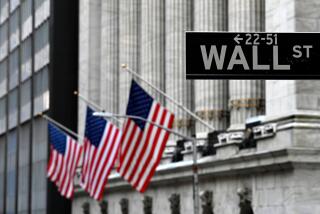What’s Not OK With Costs--a Transactional Analysis
- Share via
Leave it to a guy named Bogle to complain about mutual fund fees. But this time it isn’t John Bogle, founder and chairman of the Vanguard Group, who’s doing the talking, but his son, John Jr.
The senior Bogle has made a sport of cajoling other fund company executives to lower the operating costs they charge shareholders. On average, expenses haven’t dropped much over the last decade, even as economies of scale have improved. If anything, Bogle says, average costs in the fund business have been rising.
The senior Bogle has focused his criticism on those shareholder-borne costs that show up in the “expense ratio,” which every mutual fund must report in its prospectus. These outlays include management fees, marketing fees and various operating expenses that pay for everything from accounting help to annual reports to toll-free telephone lines.
Bogle Jr., who runs three stock funds for the n/i fund group in Boston, has taken a different tack. He is focusing on the transaction costs that portfolio managers face to buy and sell stocks. These costs are not so well-understood or visible, nor are they included in the expense ratio. But they do affect fund performance, sometimes dramatically.
The key point, says Bogle, is that mutual funds almost inevitably face escalating transaction costs--and correspondingly lower performance--as they grow larger. This, he believes, explains why most top-notch funds tend to “regress to the mean,” or see their superior performance evaporate over time.
“There’s no reason why a fund’s performance should regress to the mean, except that good performance enables managers to raise more money, which increases the fund’s transaction costs,” Bogle maintains.
Transaction costs include brokerage commissions, dealer stock markups known as “spreads,” the market impact of trading big blocks of stock quickly (i.e., the effect on the stock’s price), and the opportunity costs of having to ease into or out of a stock position over many days or even weeks.
Such transaction costs are not uniform, Bogle concedes. Managers who invest in small growth stocks tend to rack up the highest costs, whereas managers who favor large value stocks generally face the lowest expenses, especially if they follow a buy-and-hold approach.
But even under the latter scenario, costs will keep rising as a fund grows bigger and the manager places successively larger buy and sell orders.
Bogle reached that conclusion after analyzing 16,000 of his own trades, involving stocks of all sizes and investment styles, over an 18-month period. Many of the trades were made on behalf of private accounts rather than the n/i mutual funds, and sometimes it took several transactions to ease into or out of a single stock position.
Of the four transaction components, market impact and opportunity costs often are most critical, even though commissions and spreads generate most of the attention, Bogle says.
He estimates that in extreme cases, total transaction costs for a fund could eat up 10 percentage points or more in performance annually, relative to the buy-and-hold performance of passive stock indexes. So a fund with high costs would have to earn dramatically higher returns than an index just to match the index’s performance, after accounting for those high costs.
Not surprisingly, Bogle vows that the n/i funds will close their doors to new investors once they reach a certain size--$100 million for the firm’s Growth and Micro
Cap portfolios and $200 million for the Growth & Value fund. The three no-load funds ([800] 686-3742) debuted last year and thus are too young to have been rated by either Morningstar Inc. or Value Line.
In general, Bogle believes the fund industry has done a poor job of limiting asset growth for the benefit of existing shareholders. Companies have a natural incentive to boost assets, because their fees typically are set at a fixed percentage of the total dollars in a portfolio.
In addition to closing funds at relatively small asset levels, Bogle believes a solution to the cost problem would be to tie management fees directly to performance, so that companies with the best stock-picking results--not just the greatest marketing efforts--are rewarded.
More to Read
Inside the business of entertainment
The Wide Shot brings you news, analysis and insights on everything from streaming wars to production — and what it all means for the future.
You may occasionally receive promotional content from the Los Angeles Times.










